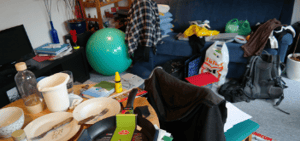While my grandpa and grandma lived in their independent living community for seniors, my mom and I would visit a couple of times each week to help with the light cleaning, such as dusting and vacuuming. The clutter we mostly left untouched until after my grandpa died. What we found was amazing: newspapers going back months, some aged candies and so on. I know, the situation could have been more challenging – they could have been hoarding.
 According to Anxiety Canada, people with hoarding disorder (HD) have difficulty discarding things that have little to no value, such as broken items. The difference between a hobbyist and someone with HD is that a hobbyist will have an organized collection while someone with HD will live in disorder. Many people with HD believe that that they might find a use for the object or have some sentimental attachment.
According to Anxiety Canada, people with hoarding disorder (HD) have difficulty discarding things that have little to no value, such as broken items. The difference between a hobbyist and someone with HD is that a hobbyist will have an organized collection while someone with HD will live in disorder. Many people with HD believe that that they might find a use for the object or have some sentimental attachment.
Dr. Peggy Richter, head of the Frederick W. Thompson Anxiety Disorders Centre in Toronto and associate professor of psychiatry with University of Toronto, estimates two to five percent of Canadians have compulsive hoarding disorder.
Potential Dangers
According to research, older adults with HD have increased health risks including:
- Falling: Pathways filled with piles of things can cause someone to trip and fall.
- Fire: The piles of possessions may topple or trap someone in the home during a fire or may even become a firestarter.
- Poor hygiene: The bathtub or shower may become a space to house more objects.
- Poor nutrition: Your loved one may choose to keep and eat expired food.
- Medical problems: Although your loved one may take their medicine as prescribed, clutter can cause more symptoms. For instance, mold and dust may worsen pulmonary disorders. Clutter may make it difficult for caregivers to enter the home to administer care.
- Insect infestations: Bugs can transmit a variety of diseases to humans.
Has your loved one’s clutter caused distress? Don’t let an excess of stuff create a wedge between you and your loved one. Be aware of possible safety concerns and do your best to provide the extra support to maintain a safe, clean home.
Check out part two coming next month.
![Duel-Logo-CFC-AYS[rgb]](https://blog.comforcare.ca/hs-fs/hubfs/Duel-Logo-CFC-AYS%5Brgb%5D.jpg?width=525&name=Duel-Logo-CFC-AYS%5Brgb%5D.jpg)